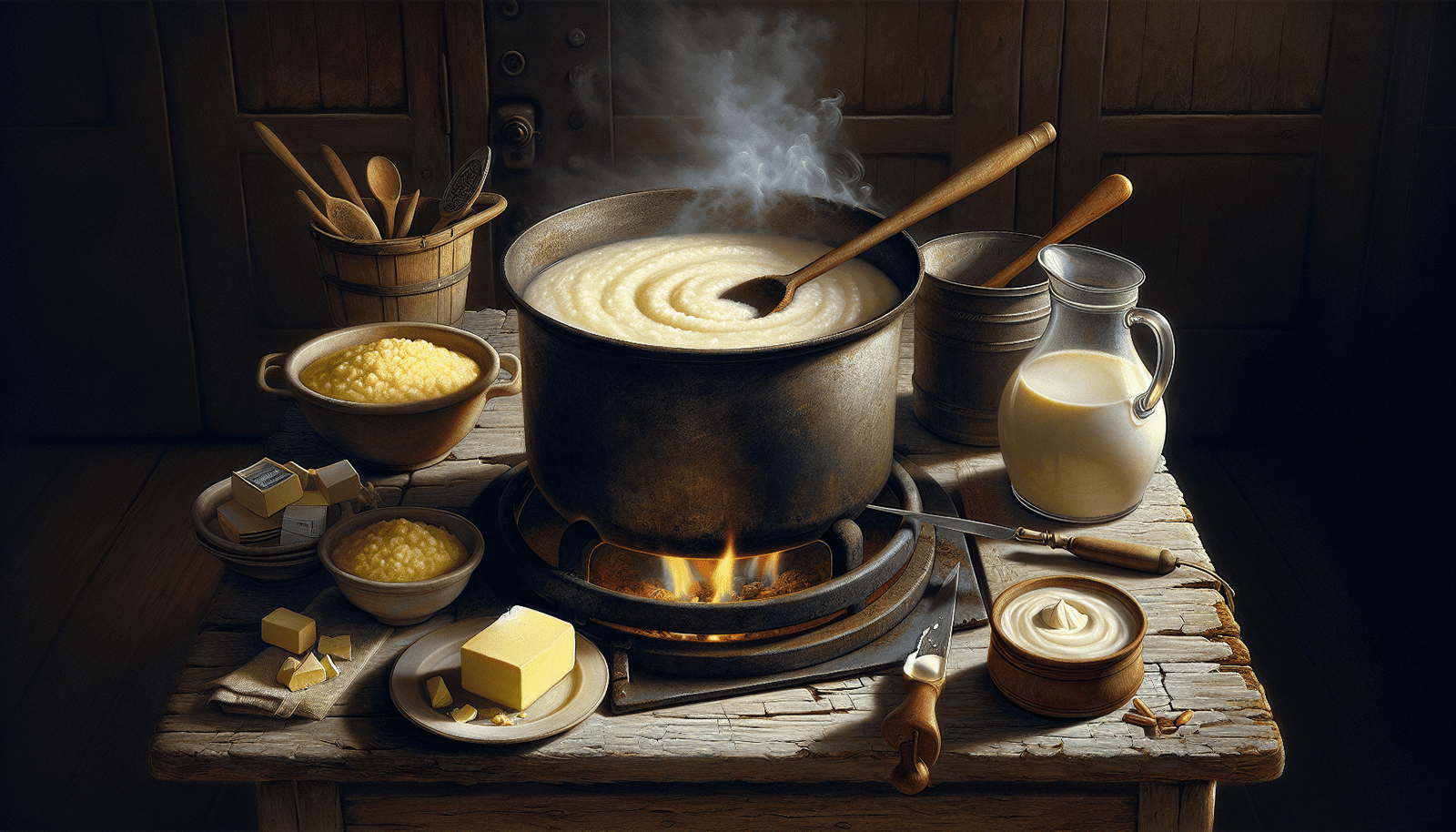If you’ve ever wondered how to make the perfect pot of creamy grits, look no further. In this article, we will share a step-by-step method that will have you enjoying a bowl of silky smooth grits in no time. From selecting the best grits to adding just the right amount of seasoning, we’ve got you covered. So grab your apron and get ready to impress your friends and family with your culinary skills.
Ingredients
Before we dive into the process of making the perfect pot of creamy grits, let’s first gather all the ingredients we’ll need. Here’s what you’ll need to make this delicious dish:
-
Grits: Grits are the star of this recipe. You can find them in the grain section of your local grocery store. Opt for stone-ground grits for the best flavor and texture.
-
Water: You’ll need water to cook the grits. Make sure to use fresh, cold water for the best results.
-
Milk: Milk adds a creamy and indulgent texture to the grits. You can use whole milk, but if you’re looking for a healthier option, you can also use low-fat or skim milk.
-
Butter: Butter adds richness and flavor to the grits. Opt for unsalted butter so that you can control the amount of salt in the dish.
-
Salt: Salt is crucial for enhancing the flavors of the grits. Use a pinch of salt to season the cooking water and adjust to your taste later on.
-
Cheese (optional): If you’re a cheese lover, you can add some grated cheese to the grits for an extra creamy and savory touch. Cheddar or Gouda cheese work particularly well.
Now that we have our ingredients ready, let’s move on to preparing and cooking the grits.
Preparing the Grits
Choosing the Right Type of Grits
When it comes to choosing the right type of grits, opt for stone-ground grits. These grits are made from whole corn kernels and provide a superior texture and flavor compared to instant or quick-cooking grits. Stone-ground grits take a bit longer to cook, but trust me, the extra time is well worth the effort.
Measure the Grits
To ensure the perfect consistency, it’s important to measure the grits accurately. For a standard serving, use a 1:4 ratio of grits to liquid. This means that for every cup of grits, you’ll need four cups of liquid, which can be a combination of water and milk.
Rinse the Grits
Before you start cooking, rinse the grits under cold water in a fine-mesh sieve. This step helps remove any impurities or debris that may be present in the grits.
Soaking the Grits (Optional)
If you have the time and want to achieve an even creamier texture, consider soaking the grits overnight in cold water. Soaking the grits helps break down the outer hull and shortens the cooking time.
Draining the Grits
If you chose to soak the grits, make sure to drain them thoroughly before cooking. This will remove any excess water and prevent your grits from turning out watery.

Cooking the Grits
Boiling the Water
To cook the grits, start by bringing the water to a boil in a large saucepan. It’s important to use a saucepan with a heavy bottom to prevent the grits from sticking or scorching.
Adding Grits to the Water
Once the water is boiling, gradually add the grits to the saucepan while continuously whisking. This will help prevent lumps from forming.
Simmering the Grits
Reduce the heat to low and let the grits simmer gently. Keep stirring occasionally to ensure even cooking and to prevent the grits from sticking to the bottom of the pan.
Stirring Occasionally
Throughout the cooking process, remember to stir the grits occasionally. This will prevent them from clumping together and ensure a smooth and creamy consistency.
Adding Milk and Salt
After the grits have cooked for about 10 minutes, it’s time to add the milk and salt. The milk will add a creamy texture and depth of flavor, while the salt will enhance the overall taste of the grits. Stir well to incorporate the milk and salt into the mixture.
Cooking Until Creamy and Tender
Continue cooking the grits over low heat until they reach a creamy and tender consistency. This usually takes around 20 to 30 minutes, depending on the type of grits you’re using. Keep tasting the grits along the way to ensure they’re cooked to your desired level of tenderness.
Adding Flavor Enhancements
Adding Butter
Once your grits are cooked to perfection, it’s time to add the butter. Add a knob of unsalted butter to the grits and stir until it melts completely. The butter adds richness and a silky texture to the dish.
Mixing in Cheese (Optional)
For all the cheese lovers out there, this is the moment you’ve been waiting for. If desired, you can add grated cheese to the grits and stir until it melts and becomes fully incorporated. This step takes the grits to a whole new level of creaminess and flavor. Cheddar or Gouda cheese work particularly well, but feel free to experiment with your favorite cheese varieties.
Seasoning with Salt and Pepper
Taste the grits and season with a pinch of salt and pepper to your liking. Remember that adding cheese already adds some saltiness, so adjust the seasoning accordingly.
Adding Herbs or Spices
To elevate the flavor profile of your grits even further, consider adding fresh herbs or spices. Chopped chives, parsley, or a sprinkle of paprika can add a touch of freshness and color to the dish. Feel free to experiment and find your perfect combination.

Consistency Adjustment
Adding More Water or Milk
If your grits turn out too thick, you can adjust the consistency by adding a splash of water or milk. Gradually add small amounts at a time, stirring continuously until you achieve your desired thickness.
Simmering for a Longer Time
Alternatively, if your grits are too thin, continue simmering them over low heat for a bit longer until they thicken up. Keep in mind that the grits will continue to thicken as they cool, so it’s better to slightly undercook them than to overcook them.
Whisking to Smooth Out Lumps
If you happen to have some lumps in your grits, fear not! You can easily smooth them out by whisking briskly. The whisking motion will break up the lumps and create a smooth and creamy texture.
Serving Suggestions
Garnishing with Herbs or Cheese
To make your grits visually appealing, consider garnishing them with a sprinkle of fresh herbs or grated cheese. This adds a touch of color and freshness that will make your dish look even more appealing.
Serving with Additional Toppings
While creamy grits are delicious on their own, you can take them to the next level by serving them with additional toppings. Sautéed shrimp, crispy bacon, or a poached egg are all fantastic choices that will add a burst of flavor and texture to your grits. Get creative and personalize your dish with your favorite ingredients.
Pairing with Complementary Dishes
Grits are a versatile dish that can be enjoyed on their own or paired with other foods. They make an excellent side dish for fried chicken, grilled steak, or roasted vegetables. Don’t be afraid to experiment and create your perfect combination.

Tips and Tricks
Pre-soak the Grits for a Creamier Texture
If you want to take your grits to the next level of creaminess, consider pre-soaking them overnight in cold water. This step helps break down the outer hull and results in a smoother and silkier texture.
Use a Heavy-Bottomed Pan to Prevent Sticking
When cooking the grits, make sure to use a heavy-bottomed saucepan. Thick-bottomed pans distribute heat more evenly and reduce the risk of the grits burning or sticking to the bottom.
Stir Continuously Towards the End of Cooking
As the grits approach their final cooking time, stir them continuously to ensure they cook evenly and don’t stick to the bottom of the pan. This will result in a perfectly creamy and smooth texture.
Experiment with Different Types of Grits
While stone-ground grits are the traditional choice, don’t be afraid to branch out and try different types. Experiment with quick-cooking grits or cornmeal grits to see which ones satisfy your taste buds.
Avoid Overcooking to Maintain the Desired Texture
It’s important not to overcook the grits, as they can quickly become mushy and lose their desired texture. Keep a close eye on them as they cook and make sure to remove them from the heat as soon as they reach a creamy and tender consistency.
Common Mistakes to Avoid
Using Too Much Liquid
Adding too much liquid, especially in the beginning, can result in watery and flavorless grits. Remember to measure the grits and liquid accurately and stick to the recommended ratios.
Cooking at Too High or Too Low Heat
Cooking grits at high heat can lead to scorching and sticking, while cooking at low heat can result in uneven cooking or undercooked grits. Aim for a gentle simmer over low to medium-low heat for the best results.
Neglecting to Rinse the Grits
Rinsing the grits before cooking is essential to remove any impurities or debris. Neglecting this step may result in gritty or sandy grits.
Not Stirring Enough
Stirring occasionally throughout the cooking process is crucial to prevent the grits from clumping together or sticking to the bottom of the pan. Neglecting to stir enough can lead to unevenly cooked grits and a lumpy texture.
Adding Cheese Too Early
If you’re adding cheese to your grits, make sure to add it towards the end of the cooking process. Adding it too early can result in the cheese melting excessively and losing its flavor.
Skipping the Seasoning Step
Salt is essential to enhance the flavors of the grits. Don’t forget to season with a pinch of salt and taste along the way to ensure a well-balanced and delicious dish.

Storing Leftover Grits
Allowing the Grits to Cool
If you have leftovers, allow the grits to cool down to room temperature before storing them. This will prevent condensation from forming and keep your grits from becoming soggy.
Transferring to an Airtight Container
Once cooled, transfer the grits to an airtight container. Glass or BPA-free plastic containers work well for storing grits.
Refrigerating for up to 4 Days
Store the grits in the refrigerator for up to four days. Beyond that, they may start to lose their texture and flavor.
Reheating on the Stovetop or Microwave
When you’re ready to enjoy your leftover grits, you can reheat them either on the stovetop or in the microwave. Add a splash of water or milk to the grits to restore their creamy consistency.
Adding a Splash of Water or Milk While Reheating
As you reheat the grits, they may thicken up. To bring them back to the desired consistency, add a splash of water or milk and stir until heated through and creamy.
Grits Variations and Adaptations
Adding Vegetables or Meat
To make your grits more substantial, consider adding sautéed vegetables or cooked meat to the dish. Sautéed spinach, roasted tomatoes, or diced bacon can add a burst of flavor and texture.
Creating a Sweet Version with Sugar and Toppings
If you have a sweet tooth, don’t despair! Grits can also be enjoyed in a sweet version. Cook the grits using the same method, but instead of salt, add a touch of sugar. Top the sweet grits with fresh berries, honey, or a drizzle of maple syrup for a delightful breakfast or dessert.
Incorporating Different Types of Cheese
While cheddar and Gouda cheese work well with grits, don’t be afraid to experiment with different varieties. Creamy goat cheese, tangy feta, or sharp Parmesan can all add unique flavors to your grits.
Experimenting with Herbs and Spices
Don’t limit yourself to just salt and pepper when seasoning your grits. Get creative and try adding herbs and spices like thyme, rosemary, or smoked paprika. These additions can elevate the flavors of your grits and make them even more irresistible.
With this comprehensive guide, you’re now armed with all the knowledge and tips you need to make the perfect pot of creamy grits. Whether you prefer them savory or sweet, plain or adorned with toppings, grits are a comforting and versatile dish that never fails to satisfy. So go ahead, gather your ingredients, and embark on a culinary journey to grits perfection!



